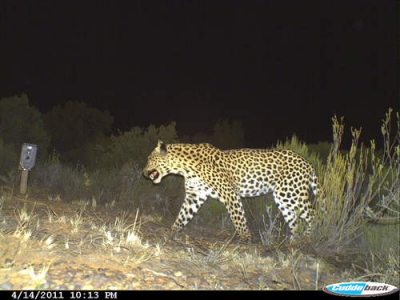In March this year, we started the first ever systematic camera trap survey of the Gouritz area. With support from the WWF Green Trust, UCT and Energizer, we were able to set up 68 cameras in the area, a far cry from the 12 cameras that were used in 2010! The aim is eventually to survey a 3000 km2 area from the Swartberg Mountains to south of the Rooiberg and Gamkaberg Mountains.
Obviously the main aim of the survey is to produce the first ever estimate of the size and density of the leopard population in the region, but as always leopards are merely the tip of the iceberg. This is by far the largest faunal biodiversity survey ever to be undertaken in this area, and we hope to gather information on a wide range of animals. In addition to surveying the mountainous areas where we know that leopards occur, we are also extending the survey to cover low-lying areas in between the mountains. This may uncover hitherto unknown leopard movement corridors through these areas. A survey of low-lying habitat may also identify species that don't share habitat with leopards, which will consequently need to be conserved and managed separately to those that live under the leopards 'umbrella'.
The first three-month phase of the survey has been completed, and the cameras are currently being moved eastwards from their initial locations around and between Ladismith and Vanwyksdorp. Unfortunately the floods which devastated the Little Karoo in mid-June also destroyed 11 of our camera traps (please see the 'Getting Involved' section of the website if you would be interested in sponsoring a replacement!), but we have nevertheless managed to get some interesting data, including the first ever photographic record of African weasels in the area (see photo below).
We would especially like to thank Energizer, who have supported us over the years by giving the Cape Leopard Trust batteries at their cost price for the camera traps and has thus made this ambitious survey feasible! Cameras get up to 3 months life with these awesome batteries. This survey will provide an important baseline for future leopard and biodiversity monitoring in the area, and we are extremely grateful to all our sponsors for supporting this endeavour!

















